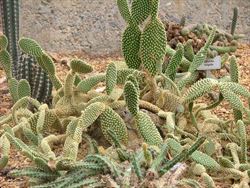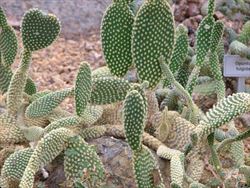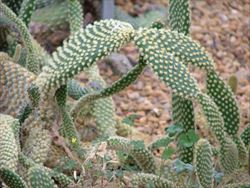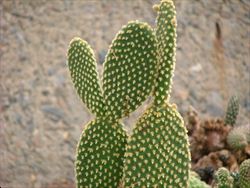Click on images to enlarge

infestation (photo: Sheldon Navie)

habit (photo: Sheldon Navie)

habit (photo: Sheldon Navie)

habit (photo: Sheldon Navie)

close-up of stems (photo: Sheldon Navie)
Scientific Name
Opuntia microdasys (Lehm.) Pfeiff.Synonyms
Opuntia rufida Engelm. is sometimes considered to be a synonym.Family
Cactaceae
Common Names
bunny ear cactus, angel's wings, golden bristle cactus
Origin
Northern and central America (south-central USA and Mexico)
Habitat
Open habitats in arid and semi-arid rangeland, also in cultivated situations.
Habit
Bunny ears forms dense shrubs 40-60 cm tall, occasionally more.
Distinguishing Features
- dense shrub to 60 cm
- yellow or white bristles
- no spines
- pads grow in pairs like rabbit ears
- flowers yellow
- Red-purple fruits
Stems and Leaves
The shrubs have no central stem but are composed of pad-like stems that grow out in pairs giving the appearance of bunny ears. The pads are green to pale green and velvety, round to oblong, 6-15 cm long and 4-12 cm broad. The pads have dense clusters of yellow or white glochids (hair-like prickles) 2-3 mm long but no spines.
Flowers and Fruit
Flowers are yellow and 3 cm wide. Fruits are fleshy, globular, 3 cm long and red-purple.
Environmental Impact
It has the potential to form extensive dense stands much like prickly pear cactus and could reduce agricultural productivity over large areas of arid and semi-arid grazing land
Legislation
A class 1 declared pest in Queensland.
Management
Landholders should report the presence of this plant to State government authorities.

